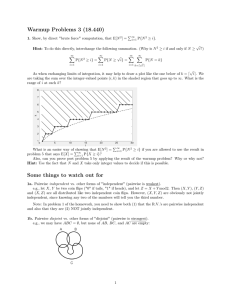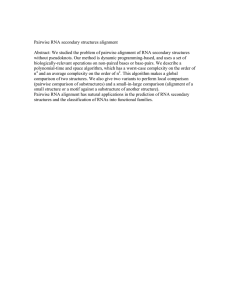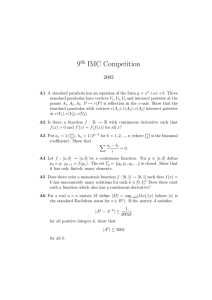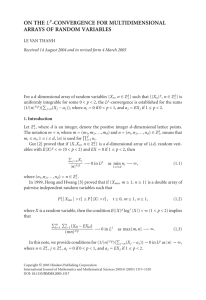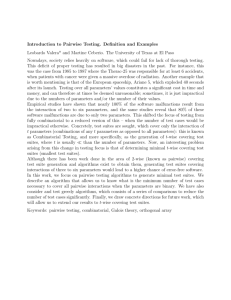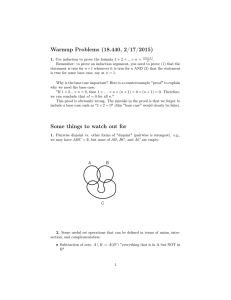60 (2008), 255–259 ON BITOPOLOGICAL PARACOMPACTNESS
advertisement
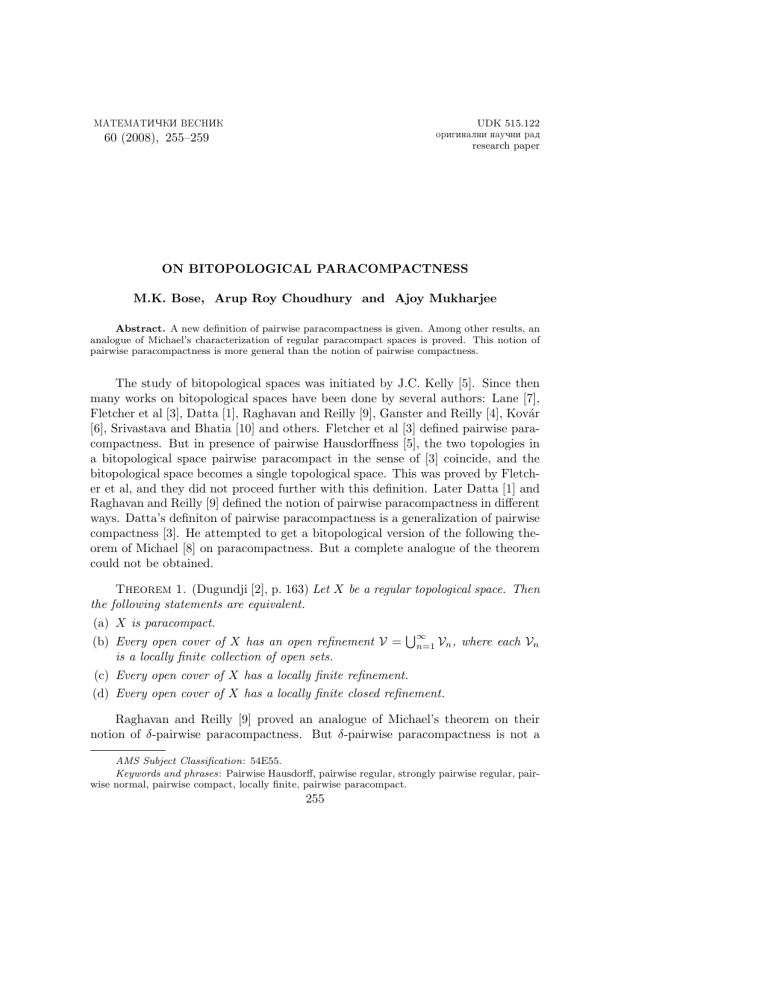
MATEMATIQKI VESNIK
UDK 515.122
originalni nauqni rad
research paper
60 (2008), 255–259
ON BITOPOLOGICAL PARACOMPACTNESS
M.K. Bose, Arup Roy Choudhury and Ajoy Mukharjee
Abstract. A new definition of pairwise paracompactness is given. Among other results, an
analogue of Michael’s characterization of regular paracompact spaces is proved. This notion of
pairwise paracompactness is more general than the notion of pairwise compactness.
The study of bitopological spaces was initiated by J.C. Kelly [5]. Since then
many works on bitopological spaces have been done by several authors: Lane [7],
Fletcher et al [3], Datta [1], Raghavan and Reilly [9], Ganster and Reilly [4], Kovár
[6], Srivastava and Bhatia [10] and others. Fletcher et al [3] defined pairwise paracompactness. But in presence of pairwise Hausdorffness [5], the two topologies in
a bitopological space pairwise paracompact in the sense of [3] coincide, and the
bitopological space becomes a single topological space. This was proved by Fletcher et al, and they did not proceed further with this definition. Later Datta [1] and
Raghavan and Reilly [9] defined the notion of pairwise paracompactness in different
ways. Datta’s definiton of pairwise paracompactness is a generalization of pairwise
compactness [3]. He attempted to get a bitopological version of the following theorem of Michael [8] on paracompactness. But a complete analogue of the theorem
could not be obtained.
Theorem 1. (Dugundji [2], p. 163) Let X be a regular topological space. Then
the following statements are equivalent.
(a) X is paracompact.
S∞
(b) Every open cover of X has an open refinement V = n=1 Vn , where each Vn
is a locally finite collection of open sets.
(c) Every open cover of X has a locally finite refinement.
(d) Every open cover of X has a locally finite closed refinement.
Raghavan and Reilly [9] proved an analogue of Michael’s theorem on their
notion of δ-pairwise paracompactness. But δ-pairwise paracompactness is not a
AMS Subject Classification: 54E55.
Keywords and phrases: Pairwise Hausdorff, pairwise regular, strongly pairwise regular, pairwise normal, pairwise compact, locally finite, pairwise paracompact.
255
256
On bitopological paracompactness
generalization of pairwise compactness. In this paper we introduce a definition of
pairwise paracompactness as a generalization of pairwise compactness and prove an
analogue of Michael’s theorem. This notion of pairwise paracompactness is slightly
different from that of Datta [1].
Let (X, P1 , P2 ) be a bitopological space. Fletcher et al [3] defined a pairwise
open cover of X: a cover U of X is a pairwise open cover if U ⊂ P 1 ∪ P2 and for
i = 1, 2, U ∩ P i contains a non-empty set. If a set E is open in the space (X, Pi ), we
write ‘E is (Pi )open’. Similarly we define (Pi )closed sets, (Pi )Fσ sets, (Pi )locally
finite collection of sets, (Pi )paracompactness etc. A pairwise open cover V of X
is said to be a parallel refinement (Datta [1]) of a pairwise open cover U if every
(Pi )open set of V is contained in some (Pi )open set of U. If x ∈ X and E ⊂ X,
by ‘E is (Pux )open’, we mean ‘E is (P1 )open (resp. (P2 )open)’ if x belongs to a
(P1 )open (resp. (P2 )open) set of U.
We introduce the following definitions:
Definition 2. A refinement V of a pairwise open cover U of X is said to be
locally finite if for each x ∈ X, there exists a (Pux )open nbd of x intersecting a
finite number of members of V.
Definition 3. The bitopological space X is pairwise paracompact if every
pairwise open cover U of X has a locally finite parallel refinement.
In the above definition, if some sets U ∈ U are both (P1 )open and (P2 )open,
then for each such set U , we select one of P1 and P2 with respect to which U is
open and for this choice, we have a locally finite refinement of U. Changing the
choice, we get a class of locally finite refinements of U.
From the definition, it follows that if X is pairwise compact [3], then it is
pairwise paracompact.
Definition 4. The bitopological space X is said to be strongly pairwise
regular if X is pairwise regular, and if both the topological spaces (X, P1 ) and
(X, P2 ) are regular.
The above notion is substantiated by giving examples.
We denote the set of real numbers and set of natural numbers by R and N
respectively. The open interval {x ∈ R | a < x < b} is denoted by (a, b).
Now we prove three results on pairwise paracompactness. The second one
(Theorem 6) is an analogue of Theorem 1.
Theorem 5. If X is pairwise Hausdorff and pairwise paracompact, then it is
pairwise normal. [5]
Proof. Let x ∈ X and F be a (Pi )closed set with x ∈
/ F . For ξ ∈ F , there exist
Uξ ∈ Pi and Vξ ∈ Pj , i 6= j such that x ∈ Uξ and ξ ∈ Vξ and Uξ ∩ Vξ = ∅. Then
the collection {Vξ | ξ ∈ F } ∪ {X − F } forms a pairwise open cover of X. Therefore
it has a locally finite parallel refinement W. Let H = ∪{W ∈ W | W ∩ F 6= ∅}.
Then H ∈ Pj and F ⊂ H. Since x ∈ X − F and X − F is a (Pi )open set, there
exists a (Pi )open nbd D of x intersecting a finite number of sets W1 , W2 ,. . . ,Wn
M.K. Bose, A.R. Choudhury, A. Mukharjee
257
of W with Wk ∩ ¡FT 6= ∅, k =
¢ 1, 2, . . . , n. Let Wk ⊂ Vξk , ξk ∈ F , k = 1,2,. . . ,n.
n
Then G = D ∩
U
∈ Pi . Also x ∈ G and G ∩ H = ∅. Thus X is
ξ
k
k=1
pairwise regular. Therefore, given two disjoint sets A and B which are (Pj )closed
and (Pi )closed (i 6= j) respectively, for x ∈ B, we get two sets Ux ∈ Pi and
Vx ∈ Pj such that A ⊂ Ux , x ∈ Vx and Ux ∩ Vx = ∅. Then the pairwise open cover
C ={Vx | x ∈ B} ∪ {X − B} of X has a locally finite parallel refinement G. If V =
∪{G ∈ G | G∩B 6= ∅}, then V ∈ Pj and B ⊂ V . Now consider a point y ∈ A. Then
y belongs to the (Pi )open set X − B of the cover C and so there exists a (Pi )open
nbd Dy of y intersecting a finite number of elements G1 (y), G2 (y), . . . , Gm (y) of
G such that for k = 1, 2, . . . , m, B ∩ Gk (y)
¡Tm6= ∅. If¢ Gk (y) ⊂ Vxk , xk ∈SB, then
Uy ∩ V = ∅ and y ∈ Uy where Uy = Dy ∩
k=1 Uxk ∈ Pi . Now if U =
y∈A Uy ,
then U ∈ Pi , A ⊂ U and U ∩ V = ∅. Therefore X is pairwise normal.
Theorem 6. If the bitopological space X is strongly pairwise regular, then the
following statements are equivalent.
(a) X is pairwise paracompact.
S∞
(b) Each pairwise open cover U of X has a parallel refinement V = n=1 Vn ,
where for each n and for each x, there exists a (Pux )open nbd of x intersecting
a finite number of members of Vn .
(c) Each pairwise open cover U of X has a locally finite refinement.
(d) Each pairwise open cover U of X has a locally finite refinement B such that if
B ⊂ U ∈ U , B ∈ B, then ((P1 )clB) ∪ ((P2 )clB) ⊂ U .
Proof. (a) ⇒ (b): Straightforward.
(b) ⇒ (c): Let U be a pairwise
S∞ open cover of X. Suppose H is a parallel
refinement of U such that H = n=1 Hn , where for each n and for each x, there
exists a (Pux )open nbd of x intersecting
a finite number of members of Hn . Let
S
Hn = {Hnα | α ∈ A}. If Wn = α H
Snα , then the collection {Wn | n ∈ N } is
a cover of X. We write En = Wn − k<n Wk . If n(x) is the first n for which
x ∈ Wn(x) , then x ∈ En(x) . So {En | n ∈ N } is a refinement of {Wn | n ∈ N }.
It is also locally finite. Indeed, there exists an α0 such that x ∈ Hn(x)α0 . Then
Hn(x)α0 is a (Pux )open nbd of x, which intersects only a finite number of members
of {En | n ∈ N }. Now the collection {En ∩ Hnα | n ∈ N, α ∈ A} is a refinement of
U. It is also locally finite. In fact, each x ∈ X has a (Pux )open nbd intersecting a
finite number of members of {En | n ∈ N }, and for each such n, the point x has a
(Pux )open nbd intersecting at most a finite number of members of {Hnα | α ∈ A}.
(c) ⇒ (d): For x ∈ X, consider Ux ∈ U with x ∈ Ux . Suppose Ux is (Pi )open.
By the strong pairwise regularity of X, there exists a (Pi )open nbd Gx of x such
that
((P1 )clGx ) ∪ ((P2 )clGx ) ⊂ Ux .
Then {Gx | x ∈ X} is a pairwise open cover of X. Therefore by (c), there is a
locally finite refinement B of {Gx | x ∈ X}, and hence of U . If B ∈ B, then for
some Gx , we have B ⊂ Gx ⊂ Ux , and so
((P1 )clB) ∪ ((P2 )clB) ⊂ ((P1 )clGx ) ∪ ((P2 )clGx ) ⊂ Ux .
258
On bitopological paracompactness
(d) ⇒ (a): Let U be a pairwise open cover of X. It is sufficient to consider
the case when there are no sets ∈ U , open with respect to both P1 and P2 . Let A
be a locally finite refinement of U. For x ∈ X, let x ∈ U ∈ U and U be (Pi )open.
Suppose Wx is a (Pi )open nbd of x intersecting a finite number of members of A.
Then W = {Wx | x ∈ X} is a pairwise open cover of X. Let E = {Eλ | λ ∈ Λ} be
a locally finite refinement of W such that if Eλ ⊂ Wx , then
((P1 )clEλ ) ∪ ((P2 )clEλ ) ⊂ Wx .
For A ∈ A, we choose UA ∈ U such that A ⊂ UA . If UA is (Pi )open, we write
[
FA = {(Pi )clE | E ∈ E, ((Pi )clE) ∩ A = ∅}.
We define GA = X −FA and HA = UA ∩GA . Obviously the collection {HA | A ∈ A}
covers X. Since UA is (Pi )open and since for each point of UA , we get a (Pi )open
nbd of x intersecting a finite number of sets ∈ E, it follows that HA is (Pi )open.
Also HA ⊂ UA . Thus {HA | A ∈ A} is a parallel refinement of U.
Now we show that {HA | A ∈ A} is locally finite. It is sufficient to show that
the collection {GA | A ∈ A} is locally finite. Let x ∈ X and Dx be a (Pux )open
nbd of x intersecting a finite number of Eλ1 , Eλ2 , . . . , Eλn of E. Now
Dx ∩ GA 6= ∅, ⇒ Eλk ∩ GA 6= ∅ for some k = 1, 2, . . . , n,
⇒ ((Pi )clEλk ) ∩ A 6= ∅ if UA is (Pi )open.
Since for each k, (Pi )clEλk is contained in some Wxk ∈ W, and Wxk intersects a
finite number of sets ∈ A, it follows that (Pi )clEλk intersects a finite number of
sets ∈ A, and hence Dx intersects a finite number of sets of {GA | A ∈ A}. Thus
{GA | A ∈ A} is locally finite.
Theorem 7. Let X be pairwise paracompact. If the topological space (X, Pj )
is regular, and if for i 6= j, F is a (Pi )Fσ proper subset of X, then F is
(Pj )paracompact.
S∞
Proof. Let F = n=1 Fn , where for each n, Fn is a (Pi )closed set. Suppose
U = {Uα | α ∈ A} is a (Pj )open cover of F . Then Uα = F ∩ Vα , where Vα is
(Pj )open in X. For each fixed n, {Vα } ∪ {X − Fn } is a pairwise open cover of
X. Hence it has a locally finite parallel refinement {Wαn }. Let Gn = S
{Wαn ∩ F |
∞
n
Wα ∩ Fn 6= ∅}. Then for each n, Gn is (Pj )locally finite. Also G = n=1 Gn is
a (Pj )open cover of F , and is a refinement of U. Therefore by Theorem 1, F is
(Pj )paracompact.
Now we present two examples of bitopological spaces: one is strongly pairwise
regular, and the other is pairwise regular but not strongly pairwise regular.
Example 8. Let a, b ∈ R with a < b, and τ be the collection of subsets G of
R for which (a, b) ⊂ R − G or G ∩ (a, b) is the union of some open subintervals of
(a, b). Then (R, τ ) is a regular topological space. If σ is the usual topology on R,
then the bitopological space (R, σ, τ ) is pairwise regular. Since the space (R, σ) is
regular, the space (R, σ, τ ) is strongly pairwise regular.
M.K. Bose, A.R. Choudhury, A. Mukharjee
259
Example 9. Suppose T = {G⊂R | R − G is a bounded set} ∪ {∅}. Then T
forms a topology on R. If σ is the usual topology on R, then the bitopological space
(R, σ, T ) is pairwise regular. But the space (R, T ) is not regular and so (R, σ, T )
is not strongly pairwise regular.
Lastly we note that the bitopological space considered in Example 4 [3, p. 330]
is pairwise compact and, hence, pairwise paracompact. It is also pairwise Hausdorff
but the topologies do no coincide.
Acknowledgement. The authors are grateful to the referee for some suggestions for the improvement of the paper.
REFERENCES
[1] M.C. Datta, Paracompactness in bitopological spaces and an application to quasi-metric
spaces, Indian J. Pure Appl. Math. (6) 8 (1977), 685–690.
[2] J. Dugundji, Topology, Allyn and Bacon, Boston, 1966.
[3] P. Fletcher, H.B. Hoyle III and C.W. Patty, The comparison of topologies, Duke Math. J.
36 (1969), 325–331.
[4] M.Ganster and I.L. Reilly, On pairwise paracompactness, J.Austral. Math. Soc. (Series A)
53 (1992), 281–285.
[5] J.C. Kelly, Bitopological spaces, Proc. London Math. Soc. (3) 13 (1963), 71–89.
[6] M.M. Kovár, A note on Raghavan-Reilly’s pairwise paracompactness, Internat. J. Math. &
Math. Sci. (2) 24 (2000), 139–143.
[7] E.P. Lane, Bitopological spaces and quasi-uniform spaces, Proc. London Math. Soc. (3) 17
(1967), 241–256.
[8] E. Michael, A note on paracompact spaces, Proc. Amer. Math. Soc. 4 (1953), 831–838.
[9] T.G. Raghavan and I.L. Reilly, A new bitopological paracompactness, J. Austral. Math. Soc.
(Series A) 41 (1986), 268–274.
[10] A. Srivastava and T. Bhatia, On pairwise R-compact bitopological spaces, Bull. Cal. Math.
Soc. (2) 98 (2006), 93–96.
(received 24.12.2007, in revised form 04.06.2008)
Department of Mathematics, University of North Bengal, Siliguri, W. Bengal-734013, India
E-mail: manojkumarbose@yahoo.com
Department of Mathematics, Malda College, Malda, W. Bengal- 732101, India
E-mail: roychoudhuryarup@yahoo.co.in
Samar Nagar, Champasari, Siliguri, W. Bengal- 734003, India
E-mail: ajoyjee@yahoo.com
